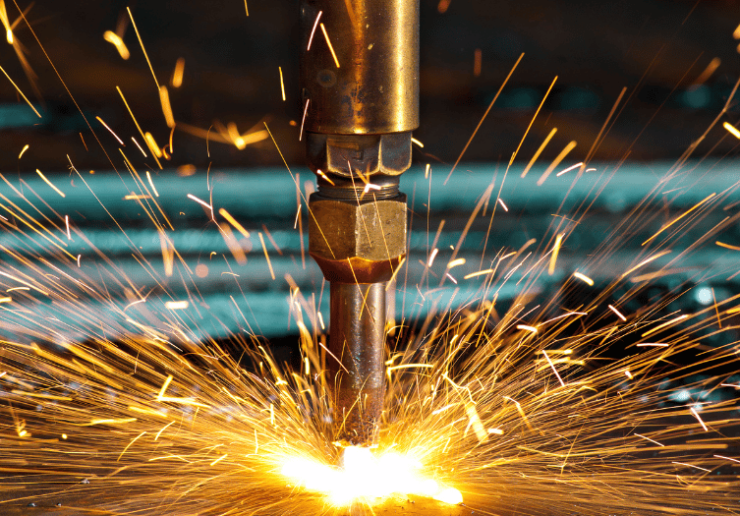Kloeckner Metals is proud to provide oxy-fuel cutting throughout its 55+ North American branches.

Oxy-fuel cutting is a thermal cutting process that uses a combination of oxygen and fuel gases to cut metal. The process works by heating the metal to its ignition temperature using a flame generated by the mixture of oxygen and fuel gas. As the metal is heated, it oxidizes and reacts with the oxygen in the flame, producing a high-temperature jet that cuts through the metal.
The most commonly used fuel gases are acetylene, propane, and natural gas. The choice of fuel gas depends on the type of metal being cut, the thickness of the metal, and the desired cutting speed.
Oxy-fuel cutting is commonly used in the steel industry and is well suited for cutting large, thick pieces of metal, as well as for producing precise cuts in plate and sheet metal. The process is also commonly used in the fabrication of structural steel, pressure vessels, and pipes.
It has some advantages over other thermal cutting processes, including low capital equipment costs, high portability, and the ability to cut most types of metal. However, the process can be hazardous and requires proper training and safety precautions, as well as specialized equipment and supplies.
Answer:
Oxy-fuel cutting can be used to cut a variety of metal shapes, including:
These are some of the common metal shapes that can be cut using the oxy-fuel cutting process. The exact metal shapes that are cut using oxy-fuel cutting will depend on the specific requirements of the manufacturer and the end use of the product.
Answer:
Yes, aluminum, stainless steel, and carbon steel can all be cut using the oxy-fuel cutting method. The oxy-fuel cutting process uses a flame that is generated by the combustion of oxygen and a fuel gas, such as acetylene or propane, to heat the metal. The metal then melts and is burned away, leaving a cut in the metal.
The specific type of metal that can be cut with the oxy-fuel cutting method depends on the thickness of the metal, the complexity of the shape, and the type of equipment that is available. In general, all three types of metal (aluminum, stainless steel, and carbon steel) can be cut with oxy-fuel cutting, although some grades of stainless steel may require special equipment or techniques to be cut effectively.
Grades of stainless steel that are relatively low in nickel content, such as 304 and 316, can be cut effectively with the oxy-fuel cutting method. These grades of stainless steel have a relatively low melting temperature and are relatively easy to cut with a high-temperature flame.
However, higher nickel content grades, such as 309 and 310, may require special equipment or techniques to be cut effectively the thermal cutting process. These grades have a higher melting temperature and may require a higher temperature flame or special shielding gases to be cut effectively.
What type of metal—sheet, plate, pipe, tube, bar, channels, angles, beams—is cut with oxy-fuel cutting?
Answer:
Oxy-fuel cutting can be used to cut a variety of metal shapes, including:
These are some of the common metal shapes that can be cut using the oxy-fuel cutting process. The exact metal shapes that are cut using oxy-fuel cutting will depend on the specific requirements of the manufacturer and the end use of the product.
Are aluminum, stainless steel, and carbon steel all cut with oxy-fuel cutting?
Answer:
Yes, aluminum, stainless steel, and carbon steel can all be cut using the oxy-fuel cutting method. The oxy-fuel cutting process uses a flame that is generated by the combustion of oxygen and a fuel gas, such as acetylene or propane, to heat the metal. The metal then melts and is burned away, leaving a cut in the metal.
The specific type of metal that can be cut with the oxy-fuel cutting method depends on the thickness of the metal, the complexity of the shape, and the type of equipment that is available. In general, all three types of metal (aluminum, stainless steel, and carbon steel) can be cut with oxy-fuel cutting, although some grades of stainless steel may require special equipment or techniques to be cut effectively.
Grades of stainless steel that are relatively low in nickel content, such as 304 and 316, can be cut effectively with the oxy-fuel cutting method. These grades of stainless steel have a relatively low melting temperature and are relatively easy to cut with a high-temperature flame.
However, higher nickel content grades, such as 309 and 310, may require special equipment or techniques to be cut effectively the thermal cutting process. These grades have a higher melting temperature and may require a higher temperature flame or special shielding gases to be cut effectively.
Today’s branch spotlight takes us to the land of deep dish pizza, full...
It’s time to celebrate one of our veteran branches, located just outside of...
Capabilities A drilling, punching, and sheering system can provide a multitude of capabilities...
What is Plasma? Before we can answer what is plasma cutting, we have...

X
The Kloeckner Metals website uses modern technologies. Unfortunately, your browser doesn't support those technologies.
Download the latest version of one of these browsers to experience the site: